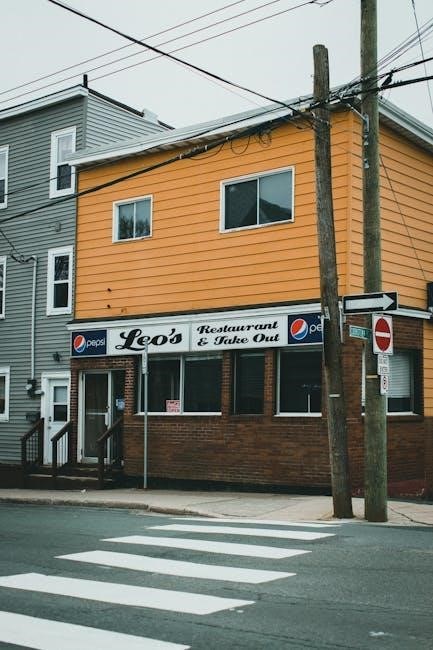Executive Summary
A restaurant business plan outlines the vision, mission, and strategies for success, targeting specific markets with unique offerings, ensuring quality meals, and excellent service to achieve profitability.
1.1. Restaurant Concept and Vision
The restaurant concept revolves around creating a welcoming, family-friendly atmosphere, offering high-quality, home-style meals at reasonable prices. The vision is to become the premier dining destination in the local community, known for its warm ambiance, exceptional service, and commitment to using fresh, locally-sourced ingredients. By focusing on customer satisfaction and building long-term relationships, the restaurant aims to establish itself as a trusted and beloved gathering place for families and food enthusiasts alike, ensuring a memorable dining experience that keeps guests returning.
1.2. Business Objectives and Mission Statement
The mission is to deliver high-quality, home-style meals with exceptional service, fostering a welcoming atmosphere for families and food enthusiasts. Key objectives include achieving cover ratios of 1.00X at each meal service, maintaining prime cost ratios below 65%, and ensuring food costs remain under 35%. The restaurant aims to become the premier dining spot in its region, prioritizing customer satisfaction, sustainable practices, and community engagement. By focusing on these goals, the establishment strives to build a loyal customer base and achieve long-term profitability while maintaining its commitment to quality and excellence.
1.3. Unique Value Proposition
The restaurant offers a distinctive dining experience by blending high-quality, locally sourced ingredients with traditional recipes, ensuring authentic flavors. Its welcoming atmosphere caters to families, couples, and food enthusiasts, providing a comfortable setting for casual and special occasions. The menu emphasizes seasonal dishes, vegetarian options, and regional specialties, appealing to diverse tastes and dietary preferences. By focusing on consistency in taste, presentation, and service, the restaurant creates a memorable experience that fosters customer loyalty and encourages word-of-mouth recommendations, setting it apart from competitors and establishing it as a preferred dining destination in the area.

Market Analysis
The market analysis outlines industry trends, target demographics, and competitive dynamics, providing insights into consumer preferences, dietary shifts, and the competitive landscape to identify opportunities and threats.
2.1. Industry Overview and Trends
The restaurant industry is highly competitive, with a growing demand for fast-casual dining and health-conscious options. Consumers increasingly prioritize quality, sustainability, and convenience. The global restaurant market is projected to reach $6;1 trillion by 2025, driven by rising disposable incomes and urbanization. Trends include plant-based cuisine, digital ordering, and eco-friendly practices. Restaurants are adopting technology to enhance customer experiences, such as online ordering and delivery services. Sustainability efforts, like reducing food waste and using locally sourced ingredients, are also gaining traction, aligning with consumer preferences and operational efficiency goals.
2.2. Target Market and Customer Segmentation
The primary target market includes urban professionals, families, and health-conscious individuals seeking quality dining experiences. Key customer segments are millennials and Gen Z, who prioritize convenience, sustainability, and unique flavors. Additionally, the restaurant will cater to local residents, office workers, and tourists. By offering diverse menu options, including vegetarian and vegan choices, the restaurant appeals to a broad audience. Market segmentation focuses on demographics, lifestyle, and dietary preferences, ensuring tailored offerings that meet the needs of each group, fostering customer loyalty and repeat visits. This approach aligns with current industry trends and consumer demands for personalized experiences.
2.3. Competitive Analysis
The restaurant will operate in a competitive market, with local eateries and chains offering similar dining experiences. Key competitors include family-owned restaurants, fast-casual chains, and upscale dining establishments. The restaurant will differentiate itself through its unique menu offerings, emphasizing fresh, locally-sourced ingredients and signature dishes. Competitive pricing, exceptional service, and a welcoming ambiance will also set it apart. By leveraging these strengths, the restaurant aims to capture a significant share of the market, attracting both loyal local customers and visitors seeking a memorable dining experience. This strategy ensures long-term sustainability in a dynamic and competitive industry landscape.

Menu and Pricing Strategy
The menu will feature diverse, high-quality dishes, blending traditional flavors with modern twists. Pricing will balance affordability and profitability, ensuring competitive value in the market;
3.1. Menu Development and Offerings
The menu will be carefully crafted to offer a variety of high-quality, flavorful dishes, blending traditional and modern cuisine. Seasonal ingredients will be sourced locally to ensure freshness and sustainability. The menu will cater to diverse dietary preferences, including vegetarian, vegan, and gluten-free options. Pricing will reflect the quality of ingredients while remaining competitive. Menu engineering techniques will be applied to optimize profitability and customer satisfaction. Regular menu updates will keep offerings fresh and aligned with market trends, ensuring the restaurant remains a preferred dining destination for a broad audience.
3.2. Pricing Strategy and Profit Margins
The pricing strategy will balance affordability with profitability, targeting a prime cost ratio below 65% and food costs under 35% of revenue. Menu items will be priced competitively, reflecting quality and portion size. Profit margins will be optimized through efficient supply chain management and cost controls. Value-based pricing will emphasize the dining experience, ensuring customer satisfaction and repeat visits. Financial projections aim to achieve sustainable profitability while maintaining accessible prices for a broad customer base, ensuring long-term viability and growth.

Operations Plan
The operations plan outlines location selection, layout design, staffing, and supply chain management to ensure efficient workflows and consistent service delivery, supporting overall business objectives and customer satisfaction.
4.1. Location and Site Selection
Location is critical for restaurant success, requiring high visibility, accessibility, and proximity to target markets. Central districts or areas with heavy foot traffic are ideal. The site should offer ample parking, easy access, and a safe environment. Lease terms and costs must align with financial projections. Evaluating nearby competition and zoning regulations ensures compliance and avoids operational hurdles. A prime location enhances brand visibility and attracts diverse customer segments, supporting long-term sustainability and growth objectives. Detailed site analysis is essential to ensure the chosen location aligns with the restaurant’s concept and business goals, driving profitability and customer satisfaction. Proper site selection is a cornerstone of operational success.
4.2. Restaurant Layout and Design
Restaurant layout and design play a pivotal role in enhancing customer experience and operational efficiency. The space should be functional, with a clear flow between dining areas, kitchen, and service zones. Seating arrangements must maximize capacity while ensuring comfort and accessibility. Lighting and decor should reflect the restaurant’s theme, creating an inviting ambiance. Accessibility features, such as ramps and restrooms, must comply with regulations. The design should also incorporate technology, like digital menus and payment systems, to streamline operations. A well-planned layout not only boosts customer satisfaction but also supports staff productivity and long-term business success, aligning with the restaurant’s brand identity and operational goals.
4.3. Staffing and Hiring Plan
The restaurant will require approximately 34 staff members, including front-of-house and back-of-house teams. Positions include chefs, waitstaff, hosts, and managers. Hiring will focus on skilled, customer-oriented individuals through online job postings and industry referrals. Comprehensive training programs will ensure staff deliver exceptional service and maintain high standards. Employee retention strategies include competitive wages, benefits, and a positive work culture. Clear role definitions and performance metrics will be established to ensure operational efficiency and customer satisfaction, aligning with the restaurant’s mission and objectives for long-term success and growth in the competitive market.
4.4. Supply Chain and Vendor Management
Efficient supply chain management is crucial for maintaining quality and profitability. The restaurant will establish relationships with reliable vendors to source fresh, high-quality ingredients. Suppliers will be selected based on cost, quality, and consistency. Payment terms and delivery schedules will be negotiated to ensure timely stock replenishment. Inventory management systems will track stock levels to minimize waste and overstocking. Regular audits will ensure compliance with food safety standards. Strong vendor partnerships will support the restaurant’s commitment to serving exceptional meals while maintaining cost efficiency and operational excellence. This approach ensures seamless operations and consistent customer satisfaction.

Financial Plan
The financial plan outlines budgeting, forecasting, and funding strategies to ensure profitability and sustainability, covering startup costs, revenue projections, and break-even analysis for informed decision-making.
5.1. Startup Costs and Funding Requirements
Startup costs for a restaurant typically include location rental, equipment, permits, and initial staffing expenses. Funding requirements may involve loans, investor contributions, or personal savings. A detailed breakdown of expenses ensures clarity, while financial projections highlight potential returns. Securing sufficient capital is crucial for covering initial operational costs and achieving long-term sustainability. Proper budgeting and funding strategies are essential to avoid financial strain and ensure the restaurant’s successful launch and growth.
5.2. Revenue Projections and Sales Forecast
Revenue projections and sales forecasts are critical components of a restaurant business plan, outlining expected income based on market analysis and customer demand. Projections are typically broken down into monthly and annual sales estimates, considering factors like average transaction value, foot traffic, and menu pricing. For example, a new restaurant might project $250,000 in first-year sales, with a 10% annual growth rate. These forecasts are supported by detailed assumptions, such as target market size, competitive pricing, and promotional strategies, ensuring a realistic and achievable financial outlook for investors and stakeholders.
5.3. Break-Even Analysis
A break-even analysis calculates the point at which a restaurant’s revenues equal its expenses, indicating profitability. It considers fixed costs like rent and equipment, variable costs such as food and labor, and average sale prices. For instance, if a restaurant has $100,000 in fixed costs, an average sale of $20, and 30% variable costs, the break-even point is 5,000 customers. This analysis helps owners understand how many customers or sales are needed to avoid losses, ensuring financial sustainability and informing pricing and operational strategies.

Marketing and Sales Strategy
Effective branding, digital marketing, and promotional campaigns attract target audiences, while loyalty programs and personalized offers enhance customer retention, driving consistent sales growth and long-term success.
6.1. Branding and Marketing Channels
Branding focuses on creating a unique identity through logos, themes, and taglines, ensuring consistency across all platforms. Marketing channels include social media, email campaigns, and local partnerships to reach diverse audiences. Utilizing templates from platforms like Canva helps maintain a professional image. Digital strategies leverage SEO and online ads to enhance visibility. Collaborative tools like Smartsheet streamline marketing workflows, ensuring cohesive campaigns. Regular updates on platforms like Instagram and Facebook engage customers, fostering loyalty and driving sales growth. These efforts collectively build brand awareness and attract target demographics effectively.
6.2. Promotional Activities and Campaigns
Promotional activities include discounts, loyalty programs, and themed events to attract customers. Digital campaigns leverage platforms like Upmetrics for targeted ads and social media engagement. Seasonal specials and limited-time offers create urgency, driving sales. Collaborations with local businesses enhance community ties. Referral programs incentivize word-of-mouth marketing. These strategies, supported by tools like Smartsheet, ensure consistent execution and measurable results. Regular promotions keep the restaurant visible, fostering customer loyalty and boosting revenue growth effectively.
6.3. Customer Retention Strategies
Effective customer retention strategies include loyalty programs, personalized offers, and exceptional service. Regular customer feedback is collected to improve dining experiences. Exclusive discounts for repeat customers foster loyalty. Digital tools like Upmetrics help track customer preferences, enabling tailored promotions. Social media engagement and email newsletters maintain customer connections. Consistent service quality ensures long-term patronage. These strategies aim to build a loyal customer base, driving repeat business and referrals, and contributing to sustainable growth and profitability for the restaurant.
The restaurant business plan outlines a clear vision and actionable objectives, supported by market analysis and financial strategies. This comprehensive approach ensures long-term success and customer satisfaction, positioning the restaurant as a leader in the industry. With a focus on quality and innovation, the next steps involve securing funding and finalizing the location to bring this vision to life.
